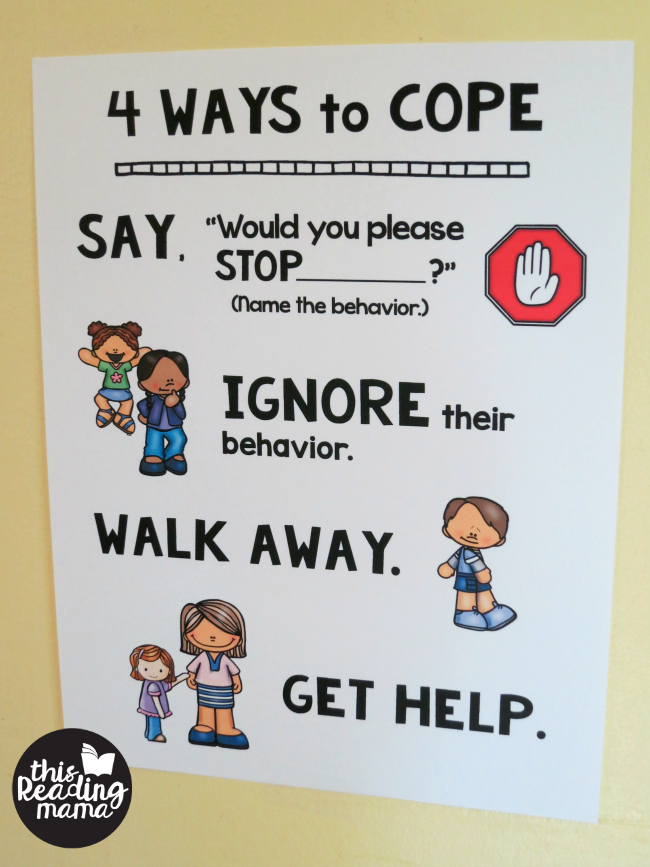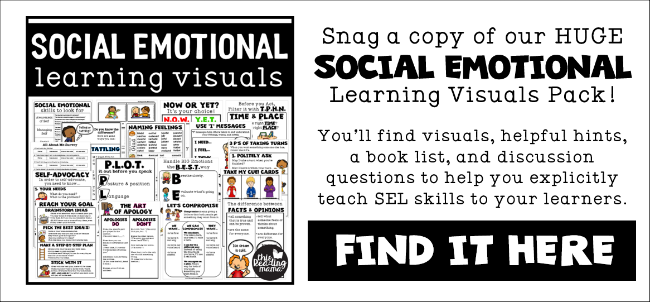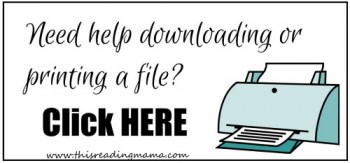Teaching kids how to solve problems in social settings is a must in my book for every child. In order to help alleviate some issues we have daily in our household {more about this in a minute}, I created a simple problem solving chart for my kids called, 4 Ways to Cope.
Find more visuals like this in our Social Emotional Learning Visuals Pack!

*You can find the free printable chart {color and b/w included} at the end of this post. Just look for the teal, oval button.
**This post contains affiliate links.
FREE Problem Solving Chart for Kids
I don’t really talk about it too much on the blog, but my oldest son was diagnosed with High Functioning Autism a little over a year ago. For him, this also means social anxiety among other social struggles, learning differences, and some sensory processing.
Often times, my oldest isn’t aware that there is a problem when he gets in his siblings’ personal space, says something that hurts their feelings, or starts making loud noises. And if I’m not in the room, these behaviors often lead to one of my youngest three screaming {and I mean screaming}, which is not on my top 10 list of things I like to hear.
While we are working with my oldest on some of those “unspoken” social rules, I felt it was also important to teach my other children how to cope when they have problems with him. I believe these strategies will help them cope with their oldest brother and with other difficult social situations/people in life. So, I created a problem solving chart to serve as a visual reminder.
I have several hanging in my house in different places where the kids interact the most.
Steps for Using the Problem Solving Chart
Now, everyone knows that a chart won’t do you any good unless you know how to use it!
1. The first step to problem solving a social situation/problem {like someone is poking you} is to politely ask the person to stop. But asking them to stop might not be enough. It is important to name the specific behavior. Example: “Would you please stop poking me on the arm?”
Why is it important to name the behavior for some kids? Because sometimes children are not even aware they are doing something that bothers the other person. It’s not even on their radar. This is true of my oldest. When his siblings shout, “Stop it! Stop it!”, he doesn’t always know what it is they want him to stop.
2. I’ve taught my own kids that are age Kindergarten and up that the next steps could be to ignore the behavior or walk away from the person. Sometimes, the person at fault is just trying to push buttons {ask me how I know}. And if the person being offended can dismantle the buttons, that’s all it takes.
3. If ignoring and walking away don’t work, the next step is to get help from a grown-up or person in charge. After my kids have tried to work it out for themselves, I step in to help.
To ensure that kids don’t jump directly to the get help step, I often ask the child getting the help, “What happened when you asked him/her to stop?” or “What happened when you walked away?”. If the child has skipped directly to the get help step, they are asked to go back and try one of the other steps first. Kids, all kids, need to learn how to work things out with another person without jumping to the get help stage. Those that do are often known as a tattle-tale.
It’s a Process
Posting a chart and talking about it doesn’t solve the problem. I know. I’m the bearer of bad news. Learning how to deal with difficult people and/or be your own advocate is a process…for all of us! Here are some next steps in the process:
- MODEL. MODEL. MODEL. Kids need to see us dealing with difficult people in this manner, too. {Easier said than done.}
- Role play.
- Give your kids the words to say and the actions to take during those difficult situations so they will know how to handle it.
- Be patient and consistent. {NOT easy advice!}
Enjoy teaching!
~Becky




I love this! Thank you for sharing and thank you for sharing a bit of your story! Really helps me out!
You are so welcome! Thanks for stopping by and commenting. 🙂
Thank you for these! I always find your materials useful. I really like this new topic. I work with students that most often are not familiar with problem solving strategies for academics or social situations.
This is a great tool and resource! It helps kids learn how to problem solve difficult situations with difficult people. Thanks a bunch!
You are very welcome! 🙂
Yes! This is wonderful! I teach these same strategies in my classroom and at home. You are correct when you say these things aren’t easy for grown ups either! Thank you! Thank you! Thank you’
You are so welcome! This is a life-long journey/process. Difficult people and social situations are hard no matter your age. 😉
Ditto!!
This is great!! Thank you for sharing!!
You’re welcome!
Thank you for the freebie! I really like that this poster isn’t busy with unnecessary visual prompts and it comes in black and white. I will be putting this up in the classroom!
It’s so funny you mention that it’s clean because I played around with borders, etc. to make it look “cute”. I didn’t want the cuteness, though, to distract from the message of the poster. So glad you can use it!
Thank you so much for this free poster. Many of my 2nd grade students want to yell at the other child, hit, or just tattle. I’ve been saying (orally) these very same steps. So, thanks for putting on a poster what I say to them at school!
You’re welcome! For my kids, it’s been so helpful to see it visually. It’s a good reminder for me, too. 🙂
I will use this! Thank you for the guidance! I especially liked your examples and steps to teaching it. I am printing several copies to use and post around our house. THANK YOU! Please bring on more social behavior type stuff. My kids (and I)LOVE your Reading the Alphabet Curriculum.
You’re very welcome! Glad your enjoying Reading the Alphabet, too!
I am going to be printing this later today! We are also a homeschooling family. We have two with special needs. One high functioning autism and one with CVI which is a vision impairment. The last two weeks seem to be filled with screaming and tattling. I’ve tried all my usual ways of solving the issue, but I think this might be the nice, fresh, visual reminder we all need. Thanks so much for sharing it with us!
Yes, the visual has really helped. It also helps that I’ve posted it in multiple places in the house. 😉
Love this! It is very much needed in my house! Can’t wait to put it into action.
This is wonderful! I’m constantly telling my kids to do these exact things when they start arguing – I think the visual will help a lot! Thanks!
Great! I’m glad you like it. 🙂
This is a nice poster as a visual reminder. Thanks for sharing. We do something similar, but now have a visual to put up to remind them. We tell them to walk away and go about your day if it is a behavior that can be ignored. Enjoy a blessed week!
Yes, walking away can be so hard for kids (and some adults) because we all want to have the last word, don’t we? Ha! You enjoy a blessed week as well!
Thank you for sharing. I’m going to hang this up. This is a good visual:)
Thanks! Glad you like it. 🙂
This is awesome. Recently working with a group of kids, I don’t know how many times I had to deal with tattling. It was simply a matter of putting the situation back in the kids’ hands most of the time. This sort of thing would have been perfect. Thank you for sharing your family’s experience with HFA. My eight-year old daughter was diagnosed at the end of her kindergarten year.
I love it! I also use your site a lot for my preschool class. Thank you!
Thanks! So glad you can use it in your classroom!
This is so helpful! Thank you for sharing. I will be printing it out right now!
You’re so very welcome!
Thanks for sharing this! I have 18 Pre-Kinders and every Spring we seem to go through the tattling phase. I’ll be printing this for sure!
I used this method in the classroom as well and it cut back on tattling quite a bit. 🙂
Thank you so very much for such a clear concise visual/poster. I am very excited to share this with my Kindergarten learners. It will be so very helpful for all of us. Thank you for sharing!
You’re very welcome!
Thank you for your insight and sharing part of your life with us. We were having a dilemma with a boy in Awana. My kids and I had a conversation about when you ask the person to stop, walk away or ignore them or if it is time to bring in an adult. In this particular situation the boy has FASD and it is difficult to know how to deal when my son gets called names, etc. The boy’s adoptive mom and I had a talk about why this might be happening and how to deal with it. We were able to explain to my kids about what is “not going on” in this boy’s brain because of choices his birth-mom made. My son has a huge heart and can empathize with others about anything it seems and since this other boy cannot, my son felt bad that the boy has to live with this for the rest of his life. It is a hard thing for some kids to comprehend brain activity or non-activity, but I feel mine grasped well what is going on and how they can better handle themselves or help the boy.
I enjoy looking at your ideas for our homeschool family. God bless you!
It’s so hard to see your kids going through difficult situations with other kids. It sounds like you did an amazing job of growing compassion in your son’s heart, which is just as important. I am working right now with my younger three, helping them understand that my oldest isn’t just being a bully or being selfish when he does some of the things he does. His brain truly is wired differently. And instead of getting angry with him (which is easy to do), we have to learn how to have compassion. Oh, such a hard lesson, but totally worth it because I know it makes us more and more like Christ. 🙂
I am excited to use your poster! This is wonderful!
Thank you for always having great items! I enjoy your newsletter!
Thank you, Dawn! Your words made my day.
This is AWESOME. Just what I need for my class this year. We’re spending lots of time on social skills and behaviors. Thanks!
Yay! So glad you can use it.
Having visual reminders around the house is a great idea. Children (and adults) respond to visuals more effectively particularly when under some form of stress. It also puts power in the kids hands where they can easily see their options and choose the right one at the time. Instead of mum or dad telling them how to deal with it. I find that they don’t really hear me when under stress anyway. Pointing to a poster is much more effective. Thankyou.
Yes! That’s what I’ve discovered, too!
I wish I would have had this earlier in the year! Thanks so much for sharing.
You’re very welcome!
Love this! It will be a great reminder for my grandchildren instead of always hearing Grandma say it!
Thank you for this poster.I wish you had posted much earlier.I teach at a public school in my country in the Caribbean (2nd graders).I can’t wait to print and post this poster in my classroom. I have some kids whose first reaction is the shouting one when others seem to bother them. I’ve tried pointing out to them to let the other person knows what they’re doing that upsets them or get them mad. Having this visual up will serve as a daily reminder of dealing with problems faced in the classroom and which I hope will extend to their individual homes where the majority of them have other siblings. I love your posts and I’m so grateful for sharing your experiences and great ideas.Will definitely be coming back for more.
This is what I’ve been trying to teach my 6 kids to do. This visual reminder will be great to help reinforce ! Thanks!
Amazing! Thank you for sharing! This is a lifelong skill everybody needs!
I have started using these methods for a year. But not all the children remember to use it. Maybe a visual poster will help them. Thank you.
Thank you for this. I have always tried to talk about this in the classroom and at home. It is nice to have a chart to refer to for the older children (even after modeling).
I teach students with special needs. The most important tool that I use in my classroom is a “visual”. These charts that you have created are absolutely perfect for ANY child!!!!! It helps them become independent, successful and feel good about themselves!!!!!! Thank you, thank you!!!! I would love to see more of your charts!!!
Absolutely love this!!! Thank you for sharing! This is definitely going up in my classroom!
Very helpful!!!love it!!!Thank you 🙂
Glad it’s helpful for you! You’re welcome. 🙂
This is perfect! I babysit/preschool three young children (my grandkids) and some days (okay, MANY days) they could definitely benefit from a visual reminder instead of just my verbal ones. Thank you!
It’s just great!! thanks a lot. Will be quite helpful both at home for my kids and for my students as well. THANKS!!
This is great! I love the size too! As a home school mom to 3 boys, this is just what we need! Thanks again!
You are very welcome.
I am late to the party on this one but just wanted to say I love it and yes please for more behavior “issues” posts. I homeschool 3 boys and some times I feel like all I do is referee all day!
Thank you so much for sharing! My son has the same type autism, and it’s tough! The teacher part of me tries to reason with the mommy in me all the time! Love, love, love the chart! Im thankful for the nudge God gave you to post this!
Yes, it’s a struggle many days, but it keeps me humble.
Becky thank you so much for sharing this. I will begin my teaching practice soon and this will help me. God bless!
I have two “button pushers”–4 and 6; and they are brothers. They’re favorite activity is pushing each other’s buttons. We have talked ad infinitum about specifying what behavior they would like the other to “stop” yet it’s never really sunk in. Thank GOD for this poster!
this is AWESOME and goes right along with what we teach in our school. The only thing I was sad about was I had wished there was one they could color in and then when I hit download there it was BONUS!!! excellent
🙂
I know I am late to the poat here, but I wanted to say thank you so much for this poster. We are mid diagnosis with my little guy and I am seeking strategy help all over the board. Its so difficult sometimes to know not only how to help him but also to help those around him. This is an amazing visual to go along with what I keep preaching all day every day so I thank you from the bottom of my heart.
Your an amazing person
Sue
Thank you, Sue! 🙂
Thank you for this article and the printables about social problem-solving. Social skills are so important, and I appreciate your help. Please keep them coming. Thank you. And thank you for all you do.
I am using this as a social skills lesson for kids at the center I work. It is an alternative education setting for students diagnosed with Autism.
Awesome!
I’m a teacher and social emotional skills are equal/ almost more important than learning to read in my kindergarten class. I teach core autism. I love this simple visual to post in my room as a reminder !!!
I have been on your site a lot and can’t believe I have missed this. Great visual, I am printing it today for end of the year and to have ready for next school year. Thank you!
Thank you for these coping strategies, I work with K-5 Special Ed. students and this visual (with pictures) will be helpful in my classroom and the one pager will be useful at my work table. I also appreciate that you do both color and black and white templates!
You’re very welcome! I’m glad you can use them with your learners!